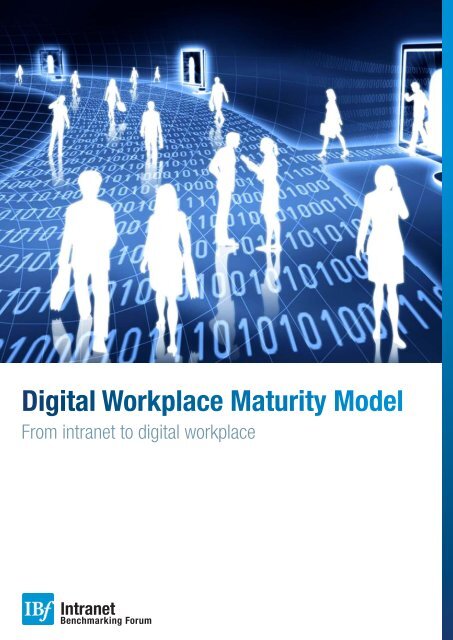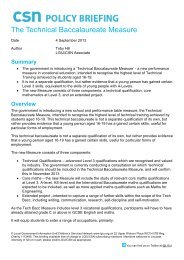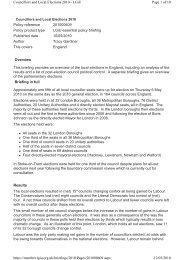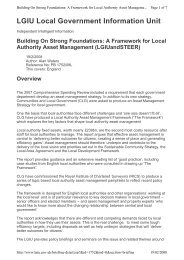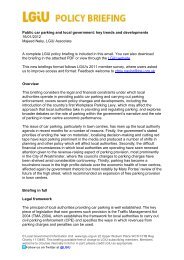Digital Workplace Maturity Model - LGiU
Digital Workplace Maturity Model - LGiU
Digital Workplace Maturity Model - LGiU
You also want an ePaper? Increase the reach of your titles
YUMPU automatically turns print PDFs into web optimized ePapers that Google loves.
2 Introduction and executive summaryThe <strong>Digital</strong> <strong>Workplace</strong> <strong>Maturity</strong> <strong>Model</strong>This report introduces the IBF <strong>Digital</strong> <strong>Workplace</strong> <strong>Maturity</strong> <strong>Model</strong> (DWMM). Drawing on IBF’sextensive experience of evaluating intranets and portals, this is a tool to help those responsiblefor managing the online working environment to understand where they are now in terms ofthe overall user experience and think strategically about future directions. By using the model,these teams will also gain insights into their organisation’s current strengths and weaknesses,with the focus on the entire ‘digital workplace’ rather than specific elements within it.Executive summaryUnderpinning the model is a belief that the traditional intranet is evolving to include the entireonline working environment: intranet, email, messaging, video, collaboration and applications.In our view, this notion of the digital workplace most accurately reflects an employee’sexperience of work, at a time when tools are often shared between intranet, web anddesktop, and the ties between the physical office and the place where work actuallyhappens are steadily dissolving.A metaphor for the digital workplaceAs a metaphor for how the digital workplace has developed, the report looks at patterns ofmarket-place evolution, from informal sets of stalls in villages to the complex array of supermarkets,market towns 1 , malls, retail parks and city centres we see today. <strong>Digital</strong> workplaces are similarlyevolving from their origins as disconnected intranets, email systems and collaboration toolsinto more managed and integrated experiences. This is not to say that every organisation muststrive for a fully-integrated, fully-featured environment: just as a small town centre can be theright fit for a regional community, so a smaller-scale solution can be the best match for a givencompany’s strategy.The maturity model dimensionsThe DWMM defines five levels of maturity, from ‘Base’ to ‘Excel’ along the four dimensions of:• Communication and information• Community and collaboration• Services• Structure.1‘Market town’ typically refers to a small rural centre, often featuring a town square. In the US the equivalentmight be referred to as ‘small town America’ with ‘Mom and Pop’ stores.5© 2010 Intranet Benchmarking Forum. All rights reserved.
Community &CollaborationServicesCommunity &CollaborationExecutive summaryBaseLowBaseLowMidMidHighicationtionStructureExcelCommunication& InformationStructureFigure 2: The DWMM can be used to visualise patterns of current andpotential maturity for an organisation.The maturity model vs benchmarkingThe DWMM, with its emphasis on the entire digital workplace, was designed Community to complement&Community &IBF’s well-developed benchmarking framework, which looks at specific Collaboration aspects of intranetCollaborationmanagement such as governance, metrics and Services processes.While benchmarking gives a very thorough view of an intranet’s current position 2 , itsays less about potential future strategy. The maturity model, by contrast, helps intranetteams think more about the bigger picture. To use another analogy, benchmarking islike a street map: it is good for detailed navigation, but when planning a grand tour ofIndia you need a physical map showing mountains, the sea and where the Taj Mahal is.tionnBaseAbout the authorLowSam Marshall is an IBF BenchmarkingMidLead and director of ClearBox Consulting(www.clearboxconsulting.co.uk). He has over 14 years’ experience in online strategy,collaboration and knowledge management. High Sam spent eight years at Unilever, wherehe was responsible for the company’s global portal implementation. This involvedoverseeing the roll-out of over 700 onlineExcelcommunities to 85,000 Structure people andStructure consolidating several thousand intranets into a single system.Communication& InformationBaseLowMid2Although the current benchmarking model uses the term ‘intranet’ it is usually interpreted more broadlyto cover the whole internal online environment, and is hence aligned with the concept of ‘digital workplace’.Community &CollaborationServicesCommunity &Collaboration7© 2010 Intranet Benchmarking Forum. All rights reserved.
4 The <strong>Digital</strong> <strong>Workplace</strong> <strong>Maturity</strong> <strong>Model</strong>OverviewThe DWMM is a tool to help organisations understand where their digital workplace is and,more importantly, develop a vision of where it might be in future. Rather than taking a strictlylinear approach, our model recognises that digital workplaces can mature along differentdimensions, namely:• Communication and information• Community and collaboration• Services• Structure.The <strong>Digital</strong> <strong>Workplace</strong><strong>Maturity</strong> modelThe model goes on to define the levels of maturity along each dimension, and finally sets outsome ‘capability patterns’ – a series of typical templates or prototypes of maturity, using themarket-place metaphor introduced in Section 2.The digital workplace vs. intranetsThe term ‘digital workplace’ is used in preference to ‘intranet’ to include all tools and applicationsused within the workplace, rather than just something produced with a content managementsystem. Figure 3 illustrates this point. Intranets are traditionally strongly associated with onlineinternal publishing (the inner circle), so can be considered one component of the digitalworkplace. Some intranets also offer more extensive but loosely-coupled facilities such asexpense claims and team collaboration sites. There may be ambiguity as to whether thesefeatures are part of the intranet or not; however they are certainly part of the digital workplace.Going further, the digital workplace concept also includes technologies that have rarely beenseen as part of intranet, but which are clearly part of the toolkit of a typical knowledge worker:web and audio conferencing; PC applications and Enterprise Resource Planning softwaresuch as SAP and PeopleSoft, for example.In keeping with this, the model is designed to encompass all online facilities, not just anindividual site. In this way it reflects the standpoint of most employees – who don’t care ifa booking system is physically part of one application or another but do care that it is easyto find, consistently designed and doesn’t need another login.9© 2010 Intranet Benchmarking Forum. All rights reserved.
TwitterfeedsDocumentmanagementE-mailWebconferencingEmployeeSelfServiceTelepresenceSupply chainmanagementNewsHR SystemsMS Office<strong>Digital</strong> workplaceLinked to IntranetTraditional IntranetPoliciesCollaboration toolsfor internal teamsGoogle DocsCorporateinformationPhone bookCollaborationtools forexternalpartnersRSSfeedsInternalsocialnetworksCRMInstantmessagingMicrobloggingExternalsocialnetworksThe <strong>Digital</strong> <strong>Workplace</strong><strong>Maturity</strong> modelFigure 3: The scope of the digital workplace compared with that of traditional intranets.The four dimensionsThe DWMM emphasises the usefulness of the workplace as a whole, rather than specific featuresof it, such as ‘travel booking’. It is structured around four dimensions, illustrated in Figure 4.sCommunity &CollaborationServicesBaseLowMidHighlnicationationStructureFigure 4: The four basic dimensions of the DWMM.ExcelCommunication& InformationesCommunity &CollaborationServices10© 2010 Intranet Benchmarking Forum. All rights reserved.
Communication and information: The role of the digital workplace for internal communicationand as an information-sharing tool. This includes news, announcements, policies, proceduresand other published reference material.Community and collaboration: How well a digital workplace supports peer-to-peer working,including collaboration as a project team or community of practice, and social connectivity(such as finding people, seeking knowledge and sharing ideas).The <strong>Digital</strong> <strong>Workplace</strong><strong>Maturity</strong> modelServices: The use of the digital workplace to deliver online applications, either for employeeself-service (e.g. absence management, expense claims or e-learning), workflow (e.g. requestapprovals, event booking) or in support of more specific functions, such as customerrelationship management (CRM) or supply chain management.Structure: This includes the management element of a digital workplace, including the extentto which sites and applications are integrated, how consistent they are, and their adherence tousability standards and governance.<strong>Maturity</strong> levelsWe also define five levels of maturity, from ‘Base’ to ‘Excel’, to define and codify the experienceof employees and leaders across all four dimensions of the digital workplace (see figure 5).Community &CollaborationServicesBaseLowMidHighnicationationStructureFigure 5: The five maturity levels of the DWMM.ExcelCommunication& InformationsCommunity &CollaborationServicesBase11Low© 2010 Intranet Benchmarking Forum. All rights reserved. Mid
1 Base Entry level, typical of an intranetor collaboration tool when it firstcomes into existence.EMPLOYEES FEEL“It’s not relevantto me.”LEADERS FEEL“It’s not relevantto me.”The <strong>Digital</strong> <strong>Workplace</strong><strong>Maturity</strong> model2 Low Some attempts at improvement,but offerings are still peripheral tothe business.“I use it when I haveto, but it can be safelyignored.”“It has no strategicrelevance. It’s somethingIT or Commsdoes.”3 Mid Relatively mature, but with roomfor improvement.“It’s mostly useful, butcan be frustrating.”“It’s a practical tool,but I don’t often getinvolved with it.”4 High The highest level an organisationwould normally expect to reach.“I couldn’t do my jobwithout it.”“Part of it is mine.”“It’s very important tohow we operate, andI support it.”5 Excel A level of maturity beyond thenorm. Strategically importantto some organisations, but notnecessarily to all.“It’s rewarding to use,and my needs are wellanticipated,”“It’s made a significantdifference to how wework.”Figure 6: The five maturity levels of the DWMM, illustrated by typical employee and leader reactions.The aim of the maturity model is to be a thinking tool to help you understand where your digitalworkspace currently is and what options you have for advancing it. The model is not meantto imply that all organisations should seek to reach the ‘Excel’ or even ‘High’ levels in allareas. Rather, it allows you to consider what pattern would provide the right template basedon your organisation’s strategy, scale and culture. The same might be said of urban planning:a market town may be prosperous because it retains unique shops and a sense of community.In such circumstances, building a state-of-the-art mall would not only be unsustainable, butwould detract from existing value.12© 2010 Intranet Benchmarking Forum. All rights reserved.
<strong>Maturity</strong> per dimensionFigures 7-10 outline the typical characteristics of an organisation’s digital workplace at eachlevel of maturity. Note that these are examples rather than exhaustive requirements. Not allthe characteristics may be true of your own organisation, but they should enable you to findthe closest match. When looking at the characteristics, consider how true they are foryour total employee base (i.e. not just workers who are currently office-based).The <strong>Digital</strong> <strong>Workplace</strong><strong>Maturity</strong> modelCOMMUNICATION AND INFORMATIONBaseLowMidHighExcelStatic information storage• The intranet is mostly used as an online store for static information such as policies.• News is updated sporadically and employees mostly get communication throughother channels.Top-down activity; static periphery• The intranet is actively used for news, but it tends to come from the centre.• Employees do not see the intranet as their main communication channel.• There is a wide array of content, but much of it is outdated.• There is no assessment of the value or quality of content.• Departmental or local sites are mostly static (e.g. part of a documentmanagement system).Multiple, managed communication levels• Most employees see the intranet as the place to go for regular news.• Some employees use online tools for two-way communication and feedback,but there are only a few examples.• There is some quality and value control around content.• Both global and local content are actively managed.• Online news is both centrally and locally produced.• Email is used primarily for local announcements only• There is ad hoc co-ordination of communications teams.Structured, flexible content and communication• Most employees prefer the intranet for nearly all communication and informationneeds.• Most employees feel that the intranet is a place where they can contribute news,opinion and information.• There is a broad mix of corporate, department, team and user-generated contentwith clear boundaries.• A wide range of media are used, including video and audio.• There is quality control appropriate to each level of content.• Content is not duplicated and there is clear ownership.• It is clear who publishes what to whom, and information is structured by audiencenot provider.• The user experience is personalised and customisable.Communication and content owned by all• The majority of employees are both publishers and consumers.• User-generated content covers all media types (e.g. video, applications).• All employees understand the different options for using the digital workplaceas a communication tool.• All employees are skilled in writing online content.Figure 7: The five maturity levels for ‘Communication and information’.13© 2010 Intranet Benchmarking Forum. All rights reserved.
COMMUNITY AND COLLABORATIONBaseLowNo specific support• No specific collaboration support – email is the main tool.• No or partially complete people finder and locally-maintained contact lists.Ad hoc use of collaboration tools• People finder is mostly complete but unreliable, or there are multiple people systems.• Most collaboration is via email and shared drives, perhaps with some niche tools forteam collaboration.• Tools in use may overlap in functionality or be ‘unofficial’, e.g. Google documents setup without IT’s knowledge.TheExecutive<strong>Digital</strong>summary<strong>Workplace</strong><strong>Maturity</strong> modelMidHighExcelWide usage of disconnected tools• There is a single address book with contact details, including some long-termcontractors.• Collaboration tools are widely used for basic tasks such as document sharing andmessaging, but are not joined up.• Social media tools are in use by some groups but are not widespread or joined up,(e.g. requiring a separate login for each).Online collaboration as a way of working• There is a comprehensive people directory, including data on skills, interestsand social networks. Contractors and partners are included.• Private collaboration spaces are widely used, e.g. by project teams.• Social media spaces for open collaboration are widely used for knowledge sharingand collaborating.• Integrated real-time collaboration tools are routinely used (e.g. presence, IM,integrated telephony such as soft phones, and web conferencing).• Employees are supported in developing skills and techniques for using these tools.• There is a programme to cultivate employee adoption of these tools.Seamless collaboration outside and in• There is permeability with the outside; employees routinely collaborate with3rd parties though the extranet and other secure environments.• Collaboration tools are fully integrated.• Immersive collaboration environments are commonly used, such as telepresenceor virtual worlds.Figure 8: The five maturity levels for ‘Community and collaboration’.14© 2010 Intranet Benchmarking Forum. All rights reserved.
SERVICESBaseLowMidHighExcelNo online services• There are no online services, though information may be provided about serviceswhich are delivered offline.Basic applications online; manual back office• Employees routinely use one or two standalone applications online.• Some services may involve online forms that are manually processed after submission.Key services online• Key employee services (HR, Finance, IT, facilities and travel) are used onlineby most employees.• Some services are limited to groups of employees (e.g. not in all countries).• Manual processes still exist.• Most ‘work’ tools (e.g. dashboards) that people use are dedicated applicationsdisconnected from each other.Services and applications used online by all• All employee services are used by all employees online.• Applications have a consistent interface and single sign-on.• There are joined-up processes and workflow (e.g. a new employee process inHR triggers IT processes for user accounts.)• Online workflow is widely used, even for local activities (e.g. departments defineworkflows for common team tasks).Employees adapt applications to needs• Employees use the intranet to combine and integrate data from multiple systems,e.g. for dashboards.• Mash-ups are used to help visualise and combine data from internal and externalsources (e.g. map overlays, semantic web).The <strong>Digital</strong> <strong>Workplace</strong><strong>Maturity</strong> modelFigure 9: The five maturity levels for ‘Services’.15© 2010 Intranet Benchmarking Forum. All rights reserved.
STRUCTUREBase No structure• There is no formal management of the digital workplace framework.• There may be multiple small intranet sites.• The intranet is not connected to anything else.LowDisconnected sites, internally structured• Multiple active intranets exist, e.g. for departments, business lines etc.• The central intranet may link to other sites or tools such as wikis, but there is nodeeper integration.• Some key sites may be well governed within themselves, but there is no consistencybetween sites.• Local sites may not be accessible to people outside that region.• Search does not index between sites.• Little or no remote access, e.g. only by staff with laptops and VPN.The <strong>Digital</strong> <strong>Workplace</strong><strong>Maturity</strong> modelMidHighExcelAggregation of principal platforms; some standards• Many sites may share a single platform, but a significant minority still sit outside.• There are standards to align look and feel, even if different platforms are used,but there are exceptions and anomalies.• Search is federated across existing sites.• Look and feel is aligned between key sites and tools.• Office-based employees use the intranet and tools other than email at least weekly.Integrated digital workplace• There is a consistent user interface throughout.• There is a consistent information architecture and metadata.• There is a single profile and login for all services and social media.• Applications are integrated behind one gateway interface.• Search can be scoped to any level (faceted search).• Nearly all employees use the intranet and most use it several times a day.• There is clear governance regarding what to manage and what to leave open touser-generated content.• Mobile use of the digital workplace is specifically designed for and supported.• Kiosk or home access is available to all employees without office PC access.<strong>Digital</strong> workplace for all• Non-PC (e.g. phones) and employee-owned devices are specifically supported.• The intranet is absorbed into other elements of the digital workplace.• Nearly all roles will incorporate the digital workplace in some form.• All employees use the digital workplace daily.• All employees use the same application for a given task.• Innovation of digital workplace features is managed and encouraged.Figure 10: The five maturity levels for ‘Structure’.16© 2010 Intranet Benchmarking Forum. All rights reserved.
5 Five maturity patternsThe DWMM is designed to take account of an organisation’s total digital workplace, rather thanjust a single element within it. This provides a more rounded reflection of a typical employee’sexperience, just as a shopper’s experience typically involves many stores and services.Five maturity patternsAn organisation’s digital workplace often evolves along different lines; for example, somewill emphasise online service or collaboration early on, whereas others will focus on tightlyintegratedcommunication and information provision. To explore this in more detail, this sectionlooks at typical maturity patterns and links them back to the market-place metaphor in Section 3.For the purposes of our metaphor:• Retail = communication and information• Social and community = online communities and collaboration• Civic and private services = employee services and applications• Town and retail planning and management = the digital workplace structure, integrationand governance.1. Market squareFigure 11: The traditional open-air market has little structure or pattern.17© 2010 Intranet Benchmarking Forum. All rights reserved.
BaseBLowMidHighcationtionOur starting point is the traditional open-air market. Excel Here, there is little structure beyondvendors setting up their stalls, quite often with numerous stalls selling the sameStructurething, andStructurewith no particular pattern to how stalls are arranged Communication(you could have a flower stall next to& Informationfishmongers, for instance). People entering a market square are likely to find it stimulating andsociable, but may need time to become familiar with it.This represents the early days of the digital workplace, where an organisation had many smallsites, each run independently and most aimed at providing basic information. Site owners weretypically entrepreneurs with basic knowledge of web software such as Front Page, who wouldusually run their site in addition to their main responsibilities. Usually organisations find this alow-value pattern and will seek to move to a more mature digital workplace.Five maturity patternsCommunity &CollaborationServicesCommunity &CollaborationBaseBLowMidHightionnStructureExcelCommunication& InformationStructureFigure 12: The ‘market square’ pattern.Community &CollaborationServicesCommunity &CollaborationBaseBasLowMidHigh18ionExcelStructure© 2010 Intranet Benchmarking Forum. All rights reserved. Communication& InformationStructure
2. Market townFive maturity patternsFigure 13: The market town shows more purposeful design, but grows organically.As the market grows, retail activity moves away from stalls and into shops. There is moreevidence of purposeful design, though each shop looks quite different. Growth is still organic– there is no overall plan and the original market stalls continue to exist. In addition, otherservices emerge, such as banks, cafes and post offices, to meet a broader range of consumerneeds. This is typical of rural centres in Europe or ‘small town America’ featuring ‘Mom andPop’ stores. People using a market town may enjoy the manageable scale and communityfeel, but feel frustrated that it lacks the convenience of a mall or a super-store.In digital workplace terms, the market town represents the emergence of key communicationsites (such as intranets) or information sites (such as document management systems) whichare well designed individually but do not connect to each other and exist alongside smaller,ad hoc sites. Some basic services such as room booking may also be offered on a standalonebasis, along with more socially-oriented facilities, such as a ‘for sale & wanted’ board. Thispattern of digital workplace is illustrated in figure 14. The ‘market town’ pattern may beappropriate for small to medium-sized enterprises where online services may not be costeffectiveand most collaboration and information needs can be easily dealt with in person.19© 2010 Intranet Benchmarking Forum. All rights reserved.
Community &CollaborationServicesCommunity &CollaborationSupermarkets represent a distinct evolutionary branch, beginning with an attempt to meetall grocery needs in one place, but in many cases expanding to cover other shoppingneeds such as toys, clothing and music. There is a great deal of order, everything hasBaseits place and no duplication is permitted except by design (e.g. prominent promotions).More recently, supermarkets have Low expanded into services too, offering pharmacies,dry cleaning and cash machines (ATMs) for example. People are typically drawn tosupermarkets for their convenience andMidpricing. However, very large stores may be hard tonavigate and feel overwhelming. Some people also resent supermarkets that squeeze outHighindependent specialist retailers that provide a more personal service.The digital workplace equivalent of a supermarket is the intranet portal: an attempt to bringStructureall content into a single, uniform experience at a Communicationlower cost than multiple platforms. PortalsStructuretypically have more controls in place and strive to & Information avoid having sites that duplicate functions,with efficiency and uniformity emphasised above community and collaboration. Althoughearly portals were often promoted as a means of delivering services too, in reality thisintegration was often superficial (in the same way that banks and food chains may openup units alongside supermarkets so that they are loosely linked). The ‘supermarket’ patternis best suited to organisations whose digital workplace priority is convenient access toinformation rather than collaboration between colleagues.ExcelBaseFive maturity patternsLowCommunity &CollaborationServicesCommunity &CollaborationBaseBaseLowLowMidMStructureHighExcelCommunication& InformationStructureFigure 16: The ‘supermarket’ pattern.Community &CollaborationServices21© 2010 Intranet Benchmarking Forum. All Baserights reserved.
4. MallFive maturity patternsFigure 17: Shopping malls provide a range of shops and services, with some autonomyfor individual units.Shopping malls (or shopping centres) represent a slightly different approach to that ofsupermarkets. Although they aim to create an ‘everything-under-one-roof’ experience,there is typically more autonomy within individual units. Often shops compete in whatthey sell. There will typically be a large department store that draws people in (an ’anchorstore‘) to the benefit of other shops there. Malls also tend to have more services andsocial areas, such as travel agents, food courts or a cinema.Some out-of-town malls have become like privately-owned town centres. Typically coveringa large, multi-unit site, they comprehensively meet shopping needs, but also provide extraamenities, For example, some civic services, such as libraries, sports facilities and postoffices, may relocate there on the grounds that this is where people are likely to congregate.22© 2010 Intranet Benchmarking Forum. All rights reserved.
unicationationStructureExcelCommunication& InformationStructureCommunity &CollaborationServicesCommunity &CollaborationFive maturity patternsBaseLowBaseLowMidMiicationtionStructureHighExcelCommunication& InformationFigure 18: The retail park is like a privately-owned town centre.StructurePeople visiting malls do so for a wide range of purposes, both social and practical. Theuniformity of malls often appeals, as it ensures consistent quality and makes it easier toaccomplish different activities. However, the experience can also feel rather sterile or synthetic.Community &CollaborationServicesCommunity &CollaborationBaseBaseLowLowMidMidHighExcelationionStructureCommunication& InformationStructureFigure 19: The ‘mall’ pattern.23© 2010 Intranet Benchmarking Forum. All rights reserved.
In digital workplace terms, the mall is like a federated approach, with several intranetsites running on a common platform, complemented by other standalone tools. Theremay be an anchor site (usually the corporate or group site) that acts as a gatewayand links to a range of other relatively independent sites. There may also be high-levelcontrols on which sites are allowed (just as a mall would stop a fish shop opening next toa bridal-wear outlet), but autonomy exists in terms of specific content. The social aspectof a mall is represented by community features within intranet sites or by social mediatools. For example, there may be discussion forums or blogs where people can interact,though these may be viewed as contrived, top-down and soulless rather than communityowned.There will also be a greater range of services incorporated to draw people in, suchas travel booking or online expenses. The ‘mall’ pattern is therefore well suited to largerorganisations where the emphasis is on efficiency and cost control.Five maturity patternsInterestingly, there is a new trend towards re-establishing market squares in some largermalls and retail parks. These may be craft or farmer’s markets, and, like user-generatedcontent on an intranet, seek to instill a sense of individuality, creativity and communitythat perhaps existed in the past but was somehow lost.5. City centresFigure 20: City centres show a mixture of top-down planning and organic growth.The final model for our analogy is the modern city centre in Europe, or the downtown districtof a US city. Growing from a ‘market town’ template, cities often mix a degree of top-downplanning with more organic growth. Like malls, they combine retail, services and socialactivities. However, they can also have a stronger sense of community or social activity,such as city squares, artistic quarters and theatres. People may visit city centres for theirvibrancy and variety, but also because, unlike malls, it is where they work and socialise.24© 2010 Intranet Benchmarking Forum. All rights reserved.
Five maturity patternsFigure 21: People both work and socialise in the city centre.The digital workplace equivalent of a city centre is one which has a degree of top-downstructure, but also nurtures bottom-up developments. While the infrastructure and servicesmay be driven centrally, much of the content will be more locally owned and managed.This approach can lead to a stronger sense of ownership and scope for innovation,but may be less efficient than the mall model. Overall, this pattern is well suited to larger,federated organisations that may have a number of relatively autonomous business units,but which are seeking to improve communication and sharing across boundaries.25© 2010 Intranet Benchmarking Forum. All rights reserved.
sCommunity &CollaborationServicesHighFive maturity patternsltionnStructureBaseLowMidHighExcelCommunication& InformationBusiness ValueLowCommunication& Information –SharingIntranetsSelf-ServiceIntranetsCollaborationDriven IntraneFigure 22: The ‘city centre’ pattern.LowInformaAs with malls (see above), there has been a renewed interest in regenerating market squaresin some cities. The same applies to the digital workspace, where we are seeing a returnto user-generated intranet content and community involvement, making the overallexperience more rewarding.Not all city centres are thriving ones: either by design or through a lack of planning somehave died and activity has moved to the outskirts. This may be a warning for organisationsthat do not nurture a healthy digital workplace inside the firewall, leaving their ‘citizens’ tolook elsewhere for information and services.26© 2010 Intranet Benchmarking Forum. All rights reserved.
6 Developing your vision in line withbusiness strategyThe DWMM is most valuable when used as a tool for thinking about future options. In terms ofthe metaphor, the task is like that of an urban planner attempting to meet the disparate needsof multiple stakeholders 3 . Future steps should be guided by:• Business strategy - what direction your organisation is taking and what role the digitalworkplace should play in this (for example, a merger would need strong communicationsand collaboration).• Employee needs – introducing easier ways for employees to do their work, and removingcurrent frustrations. Often these changes will be operational, but have widespread impact(such as improved knowledge sharing).• Culture – digital workplaces usually reflect an organisation’s culture. Those with strong topdownmanagement and a cohesive structure will be able to implement a ‘mall’ pattern moreeasily than a more federated company, for example.• Scale – company size will dictate the appropriateness of certain changes. For example,it may be more desirable for a small company to have an employee contact for benefitsadministration rather than implementing a self-service system.Developing your visionFew organisations will have the resources to develop along all dimensions at once, so aroadmap for improvement should pick one or two priority areas. When thinking about futurepatterns in relation to business strategy, each situation will be different, but there will becommon themes. For example:3See www.thoughtfarmer.com blog, 22 October 2009, which lucidly explains why intranets are a ‘wickedproblem’ involving complex systems, just like town planning.27© 2010 Intranet Benchmarking Forum. All rights reserved.
BUSINESS GOALSInnovationKnowledge sharingOrganisational change, suchas re-structuringReduce internal administrationcostsCreating a sense of ‘one’companyReducing carbon footprintDIMENSIONS TO DEVELOP‘Community and collaboration’ are important. In particular support foridea sharing and social networking. A low to mid score on ‘structure’might also be appropriate.‘Communication and information’ and ‘community and collaboration’should both be strong, so that information is accessible and there isa community context to help exploit it. ‘Structure’ is also important toensure content quality and good search performance.‘Communication and information’ should be a priority. During change,two-way communication and regular, reliable updates are particularlyimportant (aim for the ‘mid+’ level for this dimension).‘Services’ are important as these reduce transaction costs. Integrationalso matters as it lowers barriers to employee adoption (e.g.integration, usability and access to all employees should be at ‘mid’to ‘high’ levels for this dimension).‘Structure’ is important for ensuring that employees gain a sense ofa single organisation by having a single intranet, with all parts of theorganisation visible.‘Community’ is also a significant factor. Even at the ‘mid’ level havingeveryone in the same people directory can be symbolic. At higherlevels, creating spaces where employees interact across silos isimportant.‘Communication and information’ are fairly important for the reasonsgiven under ‘Organisational change’.‘Community and collaboration’ will play a role, particularly at the‘high’ to ‘excel’ levels where virtual working is strongly supported,reducing the need to travel.Developing your visionFigure 24: Aligning the dimensions to develop with business goals.As with the current state, it may be appropriate to consider a range of sub-patterns. For example,while Research and Development employees may benefit from a pattern optimised for innovation,it may not be sensible to make these features available across the organisation. Clearly thecompromise that such a strategy entails is that ‘Integration’ will not score as highly.28© 2010 Intranet Benchmarking Forum. All rights reserved.
7 DiscussionWhy have a new maturity model?There are several intranet and related maturity models for organisations to choose from(see the example from Avenue A – Razorfish, below). Whilst these can be useful as initialthinking tools, those depicting a linear growth path do not map well onto the reality of howmost intranets or digital workplaces evolve. For example, such linearity implies that intranetsdeliver services in one stage of their development followed by collaboration in the next,or that communication and information-sharing must be perfected before moving on to thenext step. The IBF <strong>Maturity</strong> <strong>Model</strong> seeks to avoid this limitation by recognising that mostdigital workplaces evolve along multiple dimensions.DiscussionHighTheConsolidated<strong>Workplace</strong>Interface<strong>Digital</strong>DashboardsBusiness ValueSelf-ServiceIntranetsCollaboration –Driven IntranetsEnterpriseInformationPortalsCommunication& Information –SharingIntranetsLowLowInformation UsageHighFig 24: The Intranet <strong>Maturity</strong> Framework TM by Razorfish – see http://intranetmaturity.comA second shortcoming of these models is that they do not cope well with the scenario ofmultiple intranets and workplace tools, such as where an organisation has a good central sitebut weaker sub-sites. By considering the whole digital workplace, the IBF model takes a moreintegrated view.There are other models of intranet evolution that claim not to be maturity models but descriptiveframeworks. The drawback of these is that they do not give sufficient detail to help digitalworkplace teams visualise what further maturity might look like. For example, a maturity scaleranging from ‘no adoption to 100% adoption’ might be a valid way to rank a digital workplace,but does not help in working out how to get further up the scale.29© 2010 Intranet Benchmarking Forum. All rights reserved.
Future maturity – where next for the most mature intranets?In creating the maturity model we envisaged an evolutionary pattern for the digital workplacethat will be stretching for many organisations but also grounded in the near future. Veryfew digital workplaces will currently rank as ‘high’ in all dimensions, while even the mostadvanced could improve by becoming better-rounded in certain areas.DiscussionFurthermore, the way in which levels of maturity are currently defined may move on. Thechannels used to communicate may involve more video (perhaps even games) and apps.At the same time, the impact of the ‘semantic web’ and the ‘green’ intranet is likely to befelt soon (these and other trends are covered by the IBF research series ‘Intranet 2015’,available on the IBF member extranet, www.ibforum.com). As well as providing an accuratepicture of the current digital workplace, the DWMM provides a framework for embracing thesechanges and ensuring that levels of employee adoption and integration are consistent withorganisational goals.30© 2010 Intranet Benchmarking Forum. All rights reserved.
Appendix: Further readingThe Intranet <strong>Maturity</strong> Framework TM . A comprehensive model developed by Avenue A –Razorfish specifically for US-based intranets. Razorfish’s ‘Stage 6’ on the ‘Consolidated<strong>Workplace</strong> Interface’ is similar to the digital workplace concept, but the idea is not articulatedat earlier stages. Available at http://intranetmaturity.comAppendix:Further readingECM <strong>Maturity</strong> <strong>Model</strong>. A detailed maturity model outlining many different dimensions andcentred on content management. The model is open-source and available at www.ecm3.orgNetJMC.net. Jane McConnell has produced a number of interesting models around intranetgrowth and maturity. Her ‘2008 Global Intranets Strategy Survey’ defined three stages ofmaturity from ‘the way of working in a few years’ to ‘the way of working now’. She has alsocommented on the Razorfish model. See:http://netjmc.typepad.com/globally_local/2006/03/essential_3_dim.htmlhttp://netjmc.typepad.com/globally_local/2006/08/report_on_best_.htmlAn earlier ‘Multiple path’ model of intranet aggregation and management is also of interest:http://netjmc.typepad.com/globally_local/2007/07/global-intranet.htmlThe Good to Great Matrix. Prescient <strong>Digital</strong> Media offers a free white paper that compares‘good’ with ‘great’ intranets based on 13 different factors. It does not claim to be a maturitymodel, but may provide useful ideas for intranets that are mid-maturity.http://www.prescientdigital.com/articles/good-to-great-intranet-matrixThe Capability <strong>Maturity</strong> <strong>Model</strong> (CMM). Considered the original maturity model, the CMM wasdeveloped at Carnegie Mellon University to assess software development processes. It hasnow been expanded to cover other business processes and renamed the Capability <strong>Maturity</strong><strong>Model</strong> Integration (CMMI). http://www.sei.cmu.edu/cmmi/The six phases of intranet evolution. An entertaining presentation by James Robertsonof Step Two Designs, describing the typical developmental history of an intranet site. Theslides with audio are at: http://www.slideshare.net/jamesr/the-six-phases-of-intranet-evolutionincludes-audioSee also ‘Future Scenario: starting a new job’ for a sketch of how the digital workplace mightfeel for a new employee. http://www.steptwo.com.au/columntwo/future-scenario-starting-a-newjob/Maslow’s ROI Hierarchy for Enterprise 2.0. Not a maturity model per se, but a thoughtprovokingmodel of how Enterprise 2.0 thinking can move from a tangible to intangible focus.http://www.cloudave.com/link/maslow-s-hierarchy-of-enterprise-2-0-roiAn empirical roadmap for intranet evolution. A more academic treatment of the topic thataddresses governance issues in detail. Developed by Antonella Martini, Mariano Corso andLuisa Pellegrini, and published in the International Journal of Information Management 29(2009) 295-308. www.elsevier.com/ijinfomgt31© 2010 Intranet Benchmarking Forum. All rights reserved.
AcknowledgementsThanks are due to those who helped shaped the thinking in this paper. They include theauthors of the other models referenced, along with the following, who kindly gave up time to beinterviewed or comment on the model:• Martin White• Ross Chestney• James Robertson• Jane McConnell• John Baptista• Angela Pohl.ExecutiveAppendix:summaryFurther readingThe paper by Martini et al (2009 – see Appendix) was also influential on our thinking about amultidimensional approach to intranet maturity.Photography:• Thanks to Sergey Kravchenko for use of the city centre photograph (figure 20).• Market place photograph (figure 11) used under Creative Commons license: Jake Keup -http://www.flickr.com/photos/keupit/ / CC BY 2.0• All other photography commissioned from Luca Sage.32© 2010 Intranet Benchmarking Forum. All rights reserved.
IBF UK officeIntranet Benchmarking Forum36 Gloucester AvenueLondon NW1 7BBUnited KingdomTel: +44 (0)20 7284 9770IBF North America officeIntranet Benchmarking Forum230 West 41st Street15th FloorNew York, NY 10036United States of AmericaTel: +1 (866) 903 0232IBF Europe officeIntranet Benchmarking ForumWorld Trade CenterLeutschenbachstrasse 958050 ZürichSwitzerlandTel: +41 (0)44 308 3961IBF Asia Pacific officeLevels 20 & 21Tower 2 Darling Park201 Sussex StreetSydney NSW 2000AustraliaTel: +61 2 9006 1634info@ibforum.com www.ibforum.comIntranetBenchmarking Forum


